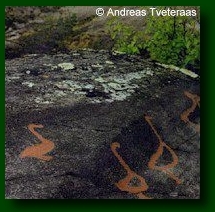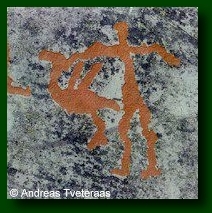
Historically the Lesser White-fronted Goose has been one of the most common goose species in North Norway. Goose hunting has been an important food resource since the humans arrived in this part of the country.
Maybe it was good hunting success he hoped for, the Stone Age man that approximately 6000 years ago made the rock carving of a goose in the slope of naked rock at Hjemmeluft/Jiebmaloukta in Alta? In another rock carving we can see a person carrying a something that looks like a goose.

"Since there are so many of them and since they are migrants that otherwise are of no use, I have never hesitated to hunt lesser white-fronted geese in spring". From Håkon Evjent's book "Finnmarks jagter", 1927.
This statement testifies that the Lesser White-fronted Goose was a common species up to recent times and that hunting intensity was high.
During moult in summer, when geese shed their flight feathers in the wings, they are unable to fly. In this period they where hunted by means of sticks or just by hand. Sometimes the geese were caught alive and held as "domestic animals". Newly grown feathers were cut and in this way locals had fresh meat throughout the whole autumn.
The intense hunting of lesser white-fronted geese here in Norway has probably affected the population, but it can probably not explain the drastic decrease that has happened the last decades. Despite the hunting, the population was quite large up till the late 1950s.